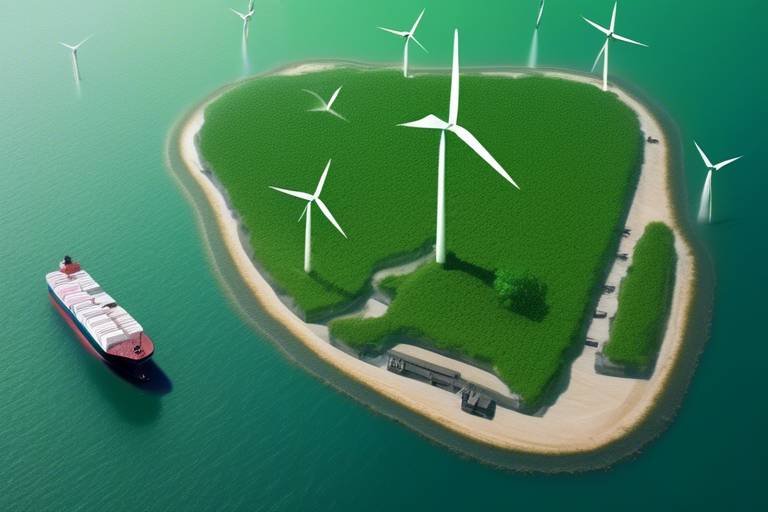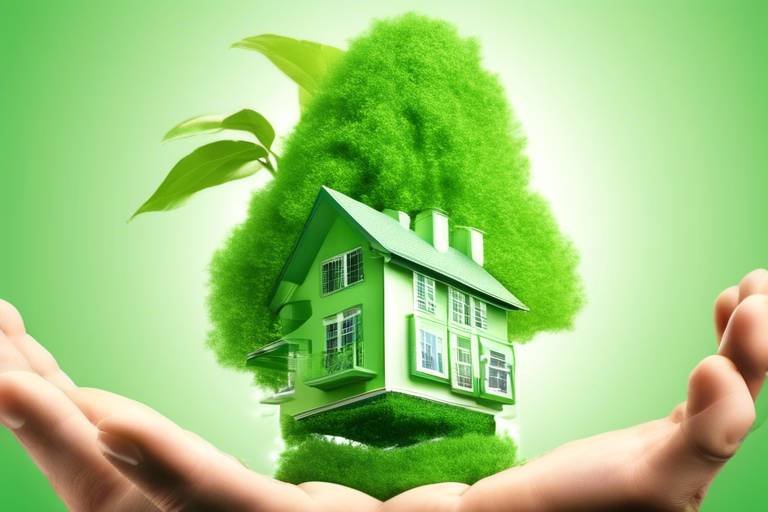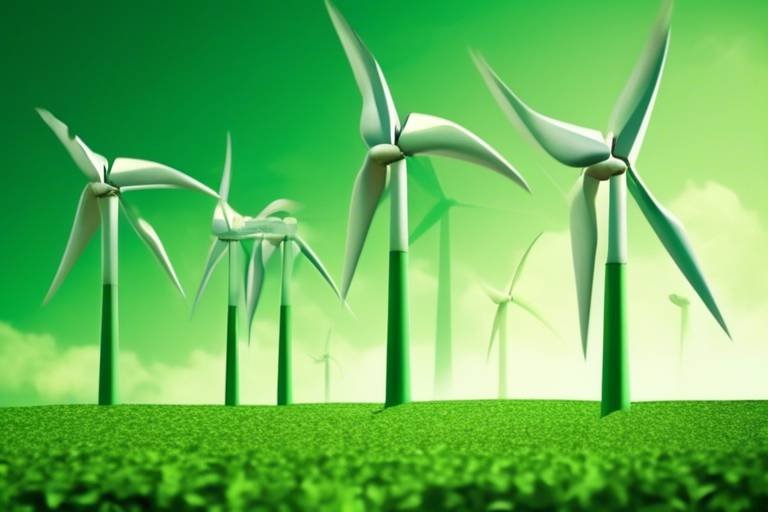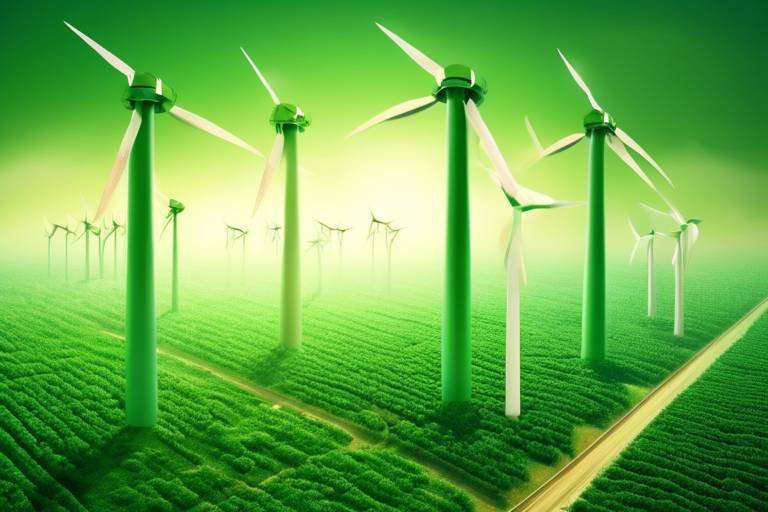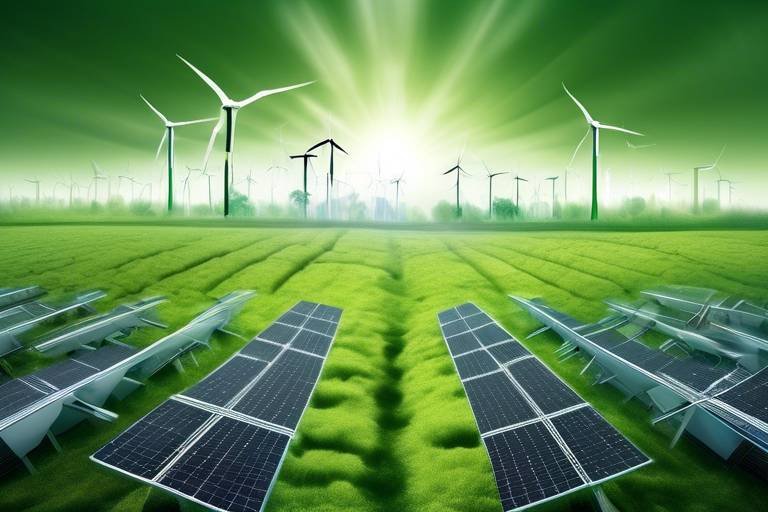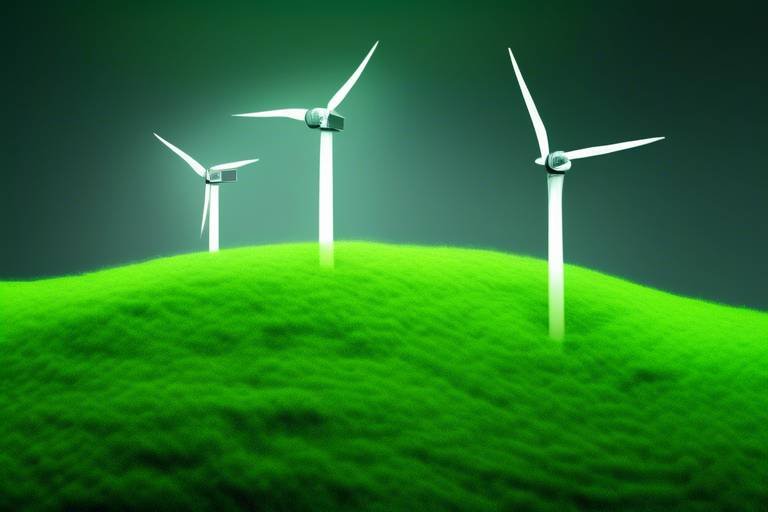Green Energy Solutions - Changing The Course of Our Future
In an era where our planet is facing unprecedented challenges, green energy solutions are emerging as a beacon of hope. These innovative practices not only aim to combat the looming threat of climate change but also promise to revolutionize our economy and enhance our daily lives. Imagine a world where energy is not just a commodity but a sustainable resource that respects our environment. This article delves into the transformative impact of green energy, exploring its significance, benefits, and the groundbreaking technologies that are paving the way for a sustainable future.
So, what exactly is green energy? At its core, it refers to energy derived from renewable sources that are naturally replenished, such as sunlight, wind, rain, tides, waves, and geothermal heat. Unlike fossil fuels, which are finite and contribute to environmental degradation, green energy offers a cleaner, more sustainable alternative. Each type of green energy plays a crucial role in combating climate change, reducing our carbon footprint, and promoting environmental stewardship. For instance, solar energy harnesses the sun's rays, while wind energy captures the kinetic energy of moving air. Together, these sources form the backbone of a sustainable energy future.
The advantages of green energy extend far beyond merely protecting our environment. Transitioning to renewable energy sources brings about a multitude of economic, health, and social benefits. Let's break it down:
One of the most significant impacts of green energy is its ability to drastically reduce greenhouse gas emissions. By shifting away from fossil fuels, we can contribute to a cleaner atmosphere and mitigate the effects of climate change. The adoption of renewable energy sources leads to a noticeable decrease in carbon dioxide and other harmful pollutants, which in turn helps preserve our planet for future generations.
Switching to renewable energy not only helps the planet but also leads to improved air quality. The reduction of harmful emissions translates into fewer respiratory illnesses and overall better health for communities. Cleaner air means healthier lives, and this is especially important in urban areas where pollution levels are often high. By embracing green energy solutions, we can breathe easier and enjoy a higher quality of life.
Utilizing renewable energy is also a critical step in conserving non-renewable resources. By investing in technologies that harness wind, solar, and other renewable sources, we ensure that resources like coal, oil, and natural gas remain available for future generations. This conservation is not just about saving resources; it’s about creating a sustainable framework for energy consumption that respects our planet's limits.
Investing in green energy is not just an environmental imperative; it’s an economic opportunity. The green energy sector is rapidly growing, creating jobs and stimulating economic growth. From manufacturing solar panels to installing wind turbines, the potential for job creation is immense. In fact, studies have shown that the renewable energy industry can generate more jobs per unit of electricity produced compared to fossil fuels. This shift not only boosts local economies but also helps communities become more resilient and self-sufficient.
Advancements in technology are crucial for the development of green energy solutions. Innovations in solar and wind energy are shaping the future of renewable energy, making it more efficient and accessible than ever before.
Solar energy technology has evolved rapidly over the past few years. With the introduction of photovoltaic cells that convert sunlight directly into electricity, solar panels have become more efficient and affordable. These advancements make it easier for homeowners and businesses to harness the sun's energy, significantly reducing their reliance on non-renewable sources.
Similarly, wind energy technology continues to improve, increasing its viability as a primary energy source. Innovations such as larger turbines and more efficient blade designs have made wind power more competitive in the energy market. As these technologies advance, we can expect wind energy to play an even larger role in our transition to a sustainable future.
- What is green energy? Green energy refers to renewable energy sources that are environmentally friendly and sustainable.
- How does green energy benefit the environment? It significantly reduces greenhouse gas emissions, improves air quality, and conserves non-renewable resources.
- Can green energy create jobs? Yes, the green energy sector is rapidly growing and has the potential to create numerous jobs in various fields.
- What technologies are driving green energy solutions? Innovations in solar and wind energy technologies are at the forefront of developing effective green energy solutions.

Understanding Green Energy
This article explores the transformative impact of green energy solutions on our environment, economy, and daily lives, highlighting innovative technologies and practices that pave the way for a sustainable future.
Green energy refers to renewable energy sources that are environmentally friendly and sustainable. Unlike fossil fuels, which are finite and contribute to pollution, green energy harnesses natural processes to generate power. This includes sources like solar, wind, hydroelectric, geothermal, and biomass. Each of these sources plays a vital role in reducing our carbon footprint and combating climate change.
One of the most compelling aspects of green energy is its ability to provide a cleaner, more sustainable alternative to traditional energy sources. For instance, solar energy captures sunlight and converts it into electricity, while wind energy utilizes the natural movement of air to generate power. These methods not only help in reducing greenhouse gas emissions but also promote energy independence and security.
Moreover, the significance of green energy goes beyond just environmental benefits. It stands as a beacon of hope in our fight against climate change, offering solutions that can lead to a more sustainable future. The integration of these renewable sources into our energy systems is not merely a trend; it's a necessity for preserving our planet for future generations.
To better understand the impact of green energy, let’s take a closer look at the different types of renewable energy sources:
| Type of Green Energy | Description | Environmental Benefits |
|---|---|---|
| Solar Energy | Energy harnessed from sunlight using solar panels. | Reduces reliance on fossil fuels and lowers greenhouse gas emissions. |
| Wind Energy | Energy generated by wind turbines converting wind into electricity. | Minimizes air pollution and conserves water resources. |
| Hydroelectric Energy | Power generated from moving water, typically from dams. | Reduces carbon emissions and provides a reliable energy source. |
| Geothermal Energy | Energy derived from the heat stored beneath the Earth's surface. | Offers a constant energy supply with minimal environmental impact. |
| Biomass Energy | Energy produced from organic materials, such as plant and animal waste. | Helps in waste reduction and can lower greenhouse gas emissions. |
By understanding these various types of green energy, we can appreciate their significance in our daily lives. They not only provide us with power but also contribute to a healthier planet. Transitioning to green energy is akin to turning over a new leaf; it represents a commitment to sustainability and a brighter future.
- What is green energy? Green energy is derived from renewable sources that are environmentally friendly, such as solar, wind, and hydroelectric power.
- Why is green energy important? It helps in reducing greenhouse gas emissions, conserves natural resources, and promotes a sustainable future.
- How can I use green energy in my home? You can install solar panels, use wind turbines, or opt for green energy providers that supply renewable energy.

Benefits of Green Energy
When we think about green energy, it’s easy to focus solely on its environmental benefits. But let’s take a moment to explore the broader picture. Transitioning to renewable energy sources like solar, wind, and hydroelectric power offers a myriad of advantages that ripple through our economy, health, and society at large. Imagine a world where energy is not only sustainable but also contributes to a thriving economy and healthier communities. Sounds appealing, right?
First off, let’s talk about the environmental impact. Green energy significantly reduces greenhouse gas emissions, which are a leading cause of climate change. By harnessing the power of nature, we can decrease our carbon footprint and contribute to a cleaner, healthier planet. This shift doesn’t just help us today; it ensures that future generations inherit a world that is not burdened by the pollution and resource depletion we see now. The significance of this cannot be overstated.
Moreover, the health benefits associated with cleaner energy are astounding. Have you ever noticed how fresh air feels invigorating? By switching to renewable energy, we can expect a dramatic improvement in air quality. Traditional energy sources like coal and oil release a plethora of harmful pollutants into the atmosphere, leading to respiratory diseases and other health issues. In contrast, green energy sources produce little to no emissions, which means cleaner air for everyone. According to recent studies, communities that have embraced renewable energy have reported a significant decrease in asthma and other respiratory illnesses. Just think about the impact this could have on our healthcare system!
Another critical aspect of green energy is the conservation of resources. Non-renewable resources such as fossil fuels are finite, and once they’re gone, they’re gone for good. By investing in renewable energy, we’re not just preserving these precious resources for future generations, but we’re also reducing our dependence on foreign oil. This transition can lead to increased energy security and independence, making our economies more resilient against global market fluctuations.
Now, let’s not forget about the economic advantages. The green energy sector is a powerhouse for job creation. As more companies invest in renewable technologies, new job opportunities are emerging in manufacturing, installation, and maintenance of green energy systems. In fact, according to the International Renewable Energy Agency, the renewable energy sector employed over 11 million people in 2018, and this number is only expected to grow. This means more jobs, more innovation, and a stronger economy overall.
To sum it all up, the benefits of green energy are vast and interconnected. It’s not just about saving the planet; it’s about creating a sustainable future that promotes health, economic growth, and resource conservation. The shift to renewable energy is not just a trend; it’s a necessity. As we continue to embrace these solutions, we pave the way for a brighter, cleaner, and more sustainable future.
- What are the main types of green energy? Green energy primarily includes solar, wind, hydroelectric, geothermal, and biomass energy.
- How does green energy benefit the economy? It creates jobs, stimulates economic growth, and reduces dependence on imported fuels.
- Is green energy more expensive than traditional energy? While initial costs can be higher, the long-term savings and environmental benefits often outweigh these costs.
- How can individuals contribute to green energy solutions? Individuals can install solar panels, support local renewable energy initiatives, and advocate for policy changes that promote green energy.

Environmental Impact
The transition to green energy is not just a trend; it’s a necessary evolution in how we power our lives and protect our planet. With the alarming rise in global temperatures and the increasing frequency of extreme weather events, the significance of adopting renewable energy sources has never been more critical. Green energy solutions, such as solar, wind, and hydroelectric power, play a pivotal role in reducing our reliance on fossil fuels, which are notorious for emitting harmful greenhouse gases. By shifting to these cleaner alternatives, we can significantly lower our carbon footprint and contribute to a healthier, more sustainable environment.
One of the most remarkable aspects of green energy is its ability to mitigate climate change. According to recent studies, transitioning to renewable energy could reduce global carbon dioxide emissions by up to 70% by 2050. This transition is essential not only for meeting international climate goals but also for ensuring a livable planet for future generations. The impact of green energy on our atmosphere is profound, leading to a decrease in pollutants that contribute to global warming and air quality degradation.
Moreover, the environmental benefits of green energy extend beyond just emissions reduction. For instance, the adoption of renewable energy sources leads to improved air quality. When we rely on fossil fuels, we release a cocktail of pollutants, including sulfur dioxide and nitrogen oxides, which can cause respiratory problems and other health issues. In contrast, renewable energy sources produce little to no emissions during operation. This shift not only helps in combating climate change but also results in cleaner air that can enhance public health. A study by the American Lung Association found that transitioning to renewable energy could prevent thousands of premature deaths and hospital visits related to air pollution.
Additionally, utilizing renewable energy contributes to the conservation of natural resources. Non-renewable resources like coal, oil, and natural gas are finite and will eventually deplete. By harnessing the power of the sun, wind, and water, we ensure that these resources are preserved for future generations. This conservation is crucial as we face the realities of resource scarcity. The table below illustrates the differences in resource depletion between renewable and non-renewable energy sources:
| Energy Source | Renewable | Non-Renewable |
|---|---|---|
| Availability | Infinite | Finite |
| Environmental Impact | Low | High |
| Resource Depletion | None | Significant |
In conclusion, the environmental impact of green energy is undeniably positive. By embracing renewable energy sources, we can combat climate change, improve air quality, and conserve precious natural resources. It’s a win-win situation that not only benefits our planet but also enhances our quality of life. As we look towards the future, the importance of green energy solutions will only continue to grow, making it imperative for individuals, businesses, and governments to prioritize sustainability in their energy choices.
- What is green energy? Green energy refers to renewable energy sources that are environmentally friendly and sustainable.
- How does green energy impact the environment? It significantly reduces greenhouse gas emissions, improves air quality, and conserves non-renewable resources.
- What are the main types of green energy? The main types include solar, wind, hydroelectric, geothermal, and biomass energy.
- Can green energy create jobs? Yes, the green energy sector is rapidly growing and creating numerous job opportunities in various fields.

Air Quality Improvement
Switching to renewable energy sources is not just a trend; it's a crucial step towards enhancing our air quality. Imagine waking up every morning to a sky that's not shrouded in smog but is instead bright and clear, where the air you breathe is fresh and invigorating. By reducing our reliance on fossil fuels, we can significantly cut down on harmful emissions that pollute our atmosphere. This transition plays a vital role in improving air quality, which is directly linked to our health and well-being.
When we talk about air pollution, we're often referring to a mix of various pollutants, including carbon monoxide, sulfur dioxide, nitrogen oxides, and particulate matter. These substances are primarily produced by burning fossil fuels for energy. However, by harnessing the power of renewable energy sources such as solar, wind, and hydroelectric power, we can drastically reduce these emissions. For instance, a study conducted by the Environmental Protection Agency (EPA) revealed that transitioning to renewable energy could reduce air pollutants by up to 70% in urban areas.
Furthermore, the health benefits of improved air quality cannot be overstated. Cleaner air leads to a decrease in respiratory diseases, cardiovascular problems, and even premature deaths. According to the World Health Organization (WHO), air pollution is responsible for an estimated 7 million deaths worldwide each year. By investing in green energy, we are not only contributing to a healthier planet but also safeguarding our health and that of future generations.
To illustrate the impact of renewable energy on air quality, let's take a look at the following table:
| Energy Source | Pollutants Reduced | Health Benefits |
|---|---|---|
| Solar Energy | Carbon Dioxide, Nitrogen Oxides | Reduced asthma attacks, improved lung function |
| Wind Energy | Particulate Matter, Sulfur Dioxide | Lower rates of heart disease, fewer hospital visits |
| Hydroelectric Energy | Carbon Monoxide, Methane | Enhanced overall public health, longer life expectancy |
In summary, the transition to renewable energy sources is essential for improving air quality. It not only reduces harmful emissions but also leads to significant health benefits for individuals and communities alike. As we embrace green energy solutions, we pave the way for a cleaner, healthier future. So, the next time you consider the benefits of renewable energy, remember that it's not just about saving the planet; it's also about breathing easier and living healthier.
- What are the main sources of air pollution? The main sources include vehicle emissions, industrial discharges, and burning fossil fuels.
- How does renewable energy improve air quality? Renewable energy reduces the reliance on fossil fuels, leading to lower emissions of harmful pollutants.
- What health benefits come from improved air quality? Improved air quality leads to reduced respiratory diseases, lower rates of heart disease, and a decrease in premature deaths.

Conservation of Resources
When we talk about conserving resources, we are essentially discussing a critical component of sustainability that impacts our planet's health and future. By utilizing renewable energy sources, we significantly reduce our reliance on non-renewable resources such as coal, oil, and natural gas. Imagine a world where our energy needs are met without depleting the earth's finite resources—this is not just a dream; it's a reality we can create through green energy solutions.
One of the most compelling reasons to embrace green energy is the conservation of our natural resources. When we harness energy from the sun, wind, and water, we are tapping into sources that are abundant and, crucially, replenishable. For instance, solar panels can generate electricity without consuming any fossil fuels, while wind turbines convert the kinetic energy of the wind into power, leaving the atmosphere untouched. This shift not only helps in reducing our carbon footprint but also ensures that our children and grandchildren inherit a planet rich in resources.
Moreover, the conservation of resources through renewable energy practices has a ripple effect on various aspects of our lives. It reduces the need for mining and drilling, which are often destructive to ecosystems. By minimizing these activities, we protect biodiversity and maintain the natural balance of our environments. The less we extract from the earth, the more we preserve its beauty and functionality for future generations. In essence, every kilowatt of green energy produced is a step towards a more sustainable and resource-efficient future.
To illustrate the impact of resource conservation, consider this table that compares the resource consumption of renewable energy versus fossil fuels:
| Energy Source | Resource Consumption | Environmental Impact |
|---|---|---|
| Solar Energy | Minimal; relies on sunlight | Low emissions, sustainable |
| Wind Energy | Minimal; relies on wind | Low emissions, sustainable |
| Coal | High; requires extensive mining | High emissions, environmental degradation |
| Natural Gas | High; requires drilling | Moderate emissions, potential for spills |
As we can see, renewable energy sources like solar and wind have a significantly lower resource consumption rate compared to fossil fuels. This is not just a statistic; it's a call to action. By choosing green energy solutions, we are making a conscious decision to protect our planet's resources. So, why not join the movement? Every small change counts, whether it's installing solar panels on your roof or supporting local wind farms. Together, we can make a substantial difference in conserving our planet's resources.
- What are renewable energy sources? Renewable energy sources include solar, wind, hydro, geothermal, and biomass. These sources are naturally replenished and have minimal environmental impact.
- How does green energy help conserve resources? Green energy reduces the need for non-renewable resources, allowing us to rely on sustainable energy sources that do not deplete the earth's finite resources.
- Can individuals contribute to resource conservation? Absolutely! Individuals can install solar panels, use energy-efficient appliances, and support policies that promote renewable energy development.
- What is the future of green energy? The future of green energy looks promising, with ongoing advancements in technology and increasing public awareness leading to broader adoption and investment.

Economic Advantages
The transition to green energy is not just an environmental necessity; it also presents a multitude of that can reshape our communities and boost our global economy. As we shift our focus from traditional, fossil fuel-based energy sources to renewable options like solar, wind, and hydroelectric power, we open the door to a wealth of opportunities. This shift is akin to planting seeds in a garden—nurturing them will yield a bountiful harvest of jobs, innovation, and sustainable growth.
One of the most significant benefits of investing in green energy is the potential for job creation. The renewable energy sector is rapidly expanding, and with it comes a demand for skilled workers. In fact, according to recent studies, jobs in the green energy field are growing at a rate that outpaces traditional industries. For instance, roles in solar panel installation, wind turbine maintenance, and energy efficiency auditing are just a few examples of how this sector is creating employment opportunities. This is not just a temporary trend; it's a long-term shift that can provide stable, well-paying jobs for millions.
Furthermore, the economic impact of green energy extends beyond job creation. It also stimulates local economies. When a community invests in renewable energy projects, it often leads to increased local spending. For example, when a solar farm is built, it requires local labor, materials, and services, which in turn supports nearby businesses. This creates a ripple effect, where the money spent on these projects circulates throughout the community, fostering economic resilience.
Additionally, transitioning to renewable energy sources can lead to significant cost savings over time. Although the initial investment in green technologies can be daunting, the long-term savings on energy bills can be substantial. For instance, homeowners who install solar panels can drastically reduce or even eliminate their electricity bills, freeing up funds for other essential needs. Moreover, as technology advances and production costs decrease, the price of renewable energy continues to drop, making it more accessible to everyone.
To illustrate the economic advantages of green energy, consider the following table that compares the job growth in renewable energy sectors versus traditional fossil fuel industries:
| Industry | Job Growth Rate (2020-2030) |
|---|---|
| Renewable Energy | 11% - 20% |
| Fossil Fuels | 1% - 5% |
As you can see, the renewable energy sector is projected to experience significantly higher job growth compared to traditional fossil fuel industries. This shift not only helps combat climate change but also strengthens our economic foundation.
In conclusion, the economic advantages of green energy are clear and compelling. By investing in renewable energy, we are not only protecting our planet but also paving the way for a more sustainable and prosperous future. The potential for job creation, local economic stimulation, and long-term cost savings makes a strong case for embracing green energy solutions. So, why wait? The time to act is now, and the rewards are waiting just around the corner!
- What are the main sources of green energy?
The primary sources include solar, wind, geothermal, hydroelectric, and biomass energy. - How does green energy contribute to job creation?
The renewable energy sector is rapidly growing, creating new jobs in installation, maintenance, and research. - Are there any financial incentives for switching to green energy?
Yes, many governments offer tax credits, rebates, and grants to encourage the adoption of renewable energy technologies. - Can green energy really reduce my electricity bills?
Absolutely! Many homeowners experience significant savings after installing solar panels or other renewable energy systems.

Innovative Technologies
In the quest for a sustainable future, play a pivotal role in enhancing the efficiency and accessibility of green energy solutions. These advancements are not just about making renewable energy sources more effective; they are about transforming the way we think about energy consumption and production. Imagine a world where your home is powered by the sun, your car runs on wind, and your community thrives on sustainable practices. Sounds like science fiction? Well, it's becoming a reality thanks to groundbreaking technologies that are reshaping the energy landscape.
One of the most exciting developments in this realm is the evolution of solar power technology. Over the past decade, the efficiency of solar panels has skyrocketed, making them a viable option for both residential and commercial use. Modern solar panels are now capable of converting more sunlight into electricity than ever before, thanks to advancements in materials and design. For instance, the introduction of monocrystalline solar cells has led to panels that are not only more efficient but also occupy less space. This means that even homeowners with limited roof space can harness the power of the sun effectively.
But it doesn’t stop there. The integration of smart technology into solar systems allows for real-time monitoring and optimization of energy production. Homeowners can now track their energy usage, adjust settings remotely, and even store excess energy for later use, all from their smartphones. This level of control empowers individuals to make informed decisions about their energy consumption, ultimately leading to significant cost savings and a reduced carbon footprint.
Similarly, wind energy innovations are making waves in the renewable sector. The design of modern wind turbines has evolved dramatically, with taller towers and larger blades that can capture more wind energy. This increase in efficiency means that wind farms can produce more electricity even in areas with lower wind speeds. Additionally, the development of offshore wind farms is revolutionizing the industry by tapping into the powerful winds over oceans, providing a consistent and robust energy source.
Moreover, the advent of floating wind turbines is a game changer. These structures can be deployed in deeper waters where traditional turbines cannot reach, significantly expanding the potential for wind energy generation. This innovation not only increases energy output but also minimizes the environmental impact, as they can be placed in areas that have less effect on marine ecosystems.
As we look to the future, it’s clear that the intersection of technology and green energy will continue to drive progress. Companies are investing heavily in research and development to create solutions that are not only efficient but also affordable. This is crucial, as the transition to renewable energy sources must be accessible to everyone. The more we innovate, the more we can democratize energy access, allowing communities around the world to benefit from clean, sustainable power.
In summary, the landscape of green energy is being transformed by innovative technologies that enhance efficiency, reduce costs, and expand accessibility. From advanced solar panels to cutting-edge wind turbines, these technologies are not just changing how we produce energy; they are changing the way we live. The future is bright, and it’s powered by green energy!
- What are the main types of green energy?
Green energy primarily includes solar, wind, hydroelectric, geothermal, and biomass energy. Each of these sources has unique benefits and applications in the quest for sustainability. - How does solar energy work?
Solar energy is harnessed through solar panels that convert sunlight into electricity using photovoltaic cells. This clean energy can be used immediately or stored for later use. - What are the benefits of wind energy?
Wind energy is renewable, reduces greenhouse gas emissions, and can create jobs in manufacturing, installation, and maintenance of wind turbines. - Are green technologies expensive?
While the initial investment can be higher, the long-term savings on energy bills and the environmental benefits often outweigh the costs. Additionally, advancements in technology are continually driving prices down.

Solar Power Developments
In recent years, the landscape of solar energy has undergone a remarkable transformation, making it one of the most promising renewable energy sources available today. With the **advancements in technology**, solar power has become not just more efficient but also more accessible to a wider audience. Imagine harnessing the sun's energy to power your home, your car, and even your community. It’s like having a **never-ending battery** at your disposal! But what exactly has changed in the world of solar power?
One of the most significant developments is the improvement in **solar panel efficiency**. Traditional solar panels converted only about 15-20% of sunlight into usable electricity. However, modern panels are pushing the boundaries, with some models achieving efficiencies of over 22%. This means that homeowners can now generate more electricity from the same amount of sunlight, making solar energy a more viable option for many.
Furthermore, the **cost of solar technology** has plummeted. Just a decade ago, the installation of solar panels was a luxury that only a few could afford. Today, due to economies of scale and technological advancements, the cost of solar installations has dropped by nearly 70%. This price reduction has opened the door for countless households and businesses to invest in solar energy. In fact, many states and countries are now offering incentives and rebates to encourage solar adoption, making it even more appealing.
To illustrate the evolution of solar technology, consider the following table that highlights the key milestones in solar power development over the past few years:
| Year | Development | Impact |
|---|---|---|
| 2015 | Introduction of PERC technology | Increased efficiency by up to 20% |
| 2017 | Cost of solar panels drops below $1/W | Widespread adoption begins |
| 2020 | Advancements in bifacial solar panels | Higher energy output |
| 2023 | Emergence of solar skin technology | Improved aesthetics and personalization |
Another exciting development is the rise of **solar energy storage systems**. With the integration of batteries, homeowners can now store excess energy produced during sunny days and use it during nights or cloudy days. This capability not only maximizes energy efficiency but also provides **energy independence**. Imagine being able to power your home even during power outages—this is the future of solar energy!
Additionally, the concept of **community solar projects** is gaining traction. These initiatives allow multiple households to share the benefits of a single solar installation, making it easier for those who may not have suitable roofs for solar panels. This collective approach to solar energy is breaking down barriers and promoting a sense of community while contributing to a more sustainable future.
In conclusion, the developments in solar power technology are not just about harnessing sunlight; they represent a **shift in our energy paradigm**. As we continue to innovate and improve, solar energy will play a crucial role in our transition to a sustainable future. So, are you ready to embrace the sun and join the solar revolution?
- What is the lifespan of solar panels? Most solar panels have a lifespan of 25-30 years, with warranties often covering that period.
- How much can I save by switching to solar energy? Savings can vary significantly based on your location, energy usage, and local solar incentives, but many homeowners see reductions of 50% or more on their energy bills.
- Can solar panels work in cloudy or rainy weather? Yes! Solar panels can still generate electricity on cloudy days, although their efficiency may be reduced.
- Are there government incentives for solar energy? Yes, many governments offer tax credits, rebates, and other incentives to encourage solar adoption.

Wind Energy Innovations
Wind energy has been making waves in the renewable energy sector, and it’s not just a breeze of change; it's a full-blown storm of innovation! With the world increasingly turning towards sustainable solutions, advancements in wind energy technology are reshaping how we harness the power of the wind. From larger and more efficient turbines to innovative offshore wind farms, the evolution of wind energy is nothing short of remarkable. Have you ever imagined how a simple gust can be transformed into electricity? Well, let's dive into some of the exciting innovations that are driving this transformation.
One of the most significant advancements in wind energy is the development of **taller and more efficient turbines**. Modern turbines can reach heights of over 300 feet, allowing them to capture stronger winds that are typically found at higher altitudes. This not only increases energy output but also makes wind farms more viable in areas that were previously considered unsuitable for wind energy production. It’s like finding a goldmine in your backyard—suddenly, the possibilities are endless!
Moreover, the **design of turbine blades** has undergone a significant overhaul. Engineers are now using advanced materials and aerodynamic designs to create blades that are longer, lighter, and more efficient. This innovation allows turbines to generate more electricity even at lower wind speeds. Picture this: a blade that can sway gracefully with the wind, capturing energy effortlessly, much like a dancer moving to the rhythm of the breeze.
Another exciting development is the rise of **floating wind farms**. Traditional wind farms are often limited to coastal areas where the seabed is suitable for anchoring turbines. However, floating wind farms can be placed in deeper waters, where winds are stronger and more consistent. This technology is a game-changer, as it opens up vast new areas for wind energy generation. Imagine a sea dotted with sleek turbines, harnessing the ocean's winds to power cities far away—it's a beautiful sight and a sustainable future!
As we look to the future, **smart technology** is also playing a crucial role in optimizing wind energy production. With the integration of artificial intelligence and machine learning, wind farms can now predict wind patterns and adjust turbine operations in real-time. This means more efficient energy production and reduced wear and tear on the equipment. It’s akin to having a personal assistant who knows exactly when to hit the gym for a workout—maximizing results while minimizing effort!
To sum it up, the innovations in wind energy are not just about harnessing the wind; they are about **revolutionizing how we think about energy**. These advancements are paving the way for a sustainable future where wind energy plays a significant role in our daily lives. As we continue to explore and invest in these technologies, we can look forward to a cleaner, greener, and more energy-efficient world.
- What are the main benefits of wind energy? Wind energy is renewable, reduces greenhouse gas emissions, and can lower electricity costs.
- How do wind turbines work? Wind turbines convert the kinetic energy of wind into mechanical energy, which is then converted into electricity.
- Are wind farms noisy? While wind turbines do produce noise, modern designs have significantly reduced sound levels, making them less intrusive.
- What is a floating wind farm? A floating wind farm is a wind energy installation that is anchored to the seabed but floats on the surface of the water, allowing for deeper water placement.
Frequently Asked Questions
- What is green energy?
Green energy refers to energy derived from renewable sources that have minimal impact on the environment. This includes solar, wind, hydro, and geothermal energy. These sources are sustainable and help in reducing our carbon footprint, making them essential in the fight against climate change.
- How does green energy benefit the environment?
Green energy significantly reduces greenhouse gas emissions, which are a major contributor to climate change. By utilizing renewable energy sources, we can improve air quality, conserve natural resources, and protect ecosystems. Essentially, it’s like giving Mother Earth a much-needed hug!
- Are there economic benefits to using green energy?
Absolutely! Transitioning to green energy can create jobs in manufacturing, installation, and maintenance of renewable energy systems. Additionally, it can stimulate local economies and reduce energy costs in the long run, making it a win-win for everyone!
- What are some innovative technologies in green energy?
There are many exciting advancements in green energy technologies! For instance, solar panels have become more efficient and affordable, while wind turbines are now designed to capture even more energy from the breeze. Innovations like energy storage solutions and smart grids are also paving the way for a more sustainable future.
- How does solar energy work?
Solar energy works by capturing sunlight using photovoltaic cells in solar panels, which convert sunlight into electricity. This clean energy can then be used to power homes, businesses, and even electric vehicles. Think of it as harnessing the sun’s power to light up our lives!
- What is the role of wind energy in green energy solutions?
Wind energy plays a crucial role by using wind turbines to convert kinetic energy from the wind into electricity. It's one of the fastest-growing renewable energy sources, providing clean power while also being a cost-effective solution for many regions around the world.
- Can green energy sources meet all our energy needs?
While green energy sources are growing rapidly, a complete transition to renewables is still a work in progress. However, with advancements in technology and energy storage, we are moving closer to a future where renewable energy can meet a significant portion of our energy demands.
- How can individuals contribute to green energy initiatives?
Individuals can make a difference by using energy-efficient appliances, reducing energy consumption, and considering the installation of solar panels. Supporting policies that promote renewable energy and educating others about the benefits of green energy are also great ways to contribute!




